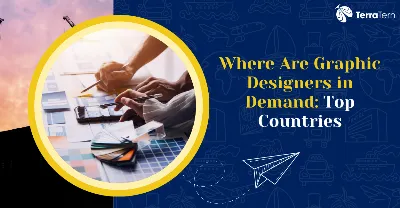Key Highlights
- Where Are Graphic Designers in Demand in 2025-26?
- Which Countries Have the Highest Demand for Graphic Designers in 2025-26?
- Which Industries Are Hiring Graphic Designers Most Actively?
- What Skills Are Most In-Demand for Graphic Designers in 2025?
- How Can Indian Graphic Designers Access International Opportunities in 2025-26?
- What Is the Salary Range for Graphic Designers in Different Countries?
- How Is AI Affecting Graphic Design Job Demand in 2025-26? Experts Insights
- What Are the Future Trends Shaping Graphic Design Demand in 2025-26?
- How Can TerraTern Help You Get a Graphic Designer Job Abroad?
- The Future of Graphic Design: 2025 Market Trends & Statistics
- Conclusion
Where are graphic designers in demand? This has turned out to be an essential question for creative professionals who need career growth in 2025. Digital revolution, digital e-Commerce growth, and content-driven marketing strategies have given graphic designers unprecedented opportunities across developed Asia. The many industries for which highly sophisticated designers are drawing the most attention, such as technology, advertising, gaming and digital media, provide lucrative opportunities for designers in the
Where Are Graphic Designers in Demand in 2025-26?

Where are graphic designers in demand has been proven with significant market evidence: graphic designers are in high demand across major cities like New York, London, San Francisco, Bengaluru, and Mumbai, with strong opportunities in technology, e-commerce, digital marketing, and creative industries.
The global graphic design market size was at $47.03 billion in 2024 and is forecast to $83.61 billion by 2034, at an annual growth rate of 5.9%. With more than 62,000 job openings now available around the world and a projected rise in jobs of 3% through 2031, there are more designer opportunities than ever in the digital, consumer goods, and technology sectors.
Key Market Statistics for Graphic Designers (2025-2034)
|
Statistic |
Value |
|
Global graphic design market value (2024) |
$47.03 billion |
|
Market projection (2030) |
$78.25 billion |
|
Market projection (2034) |
$83.61 billion |
|
Compound Annual Growth Rate (CAGR) until 2029 |
8.1% |
|
Employment growth through 2031 |
3% |
|
Current global job openings (2025) |
62,000+ |
|
Estimated annual new job positions |
22,800 |
|
Percentage of companies using graphic design |
81% |
|
Global per capita income growth impact |
2.8% |
Note: As per our expert Shreya, with 5.9% annual growth and 22,800 new jobs created yearly, graphic design remains a resilient career path despite AI automation concerns, as businesses increasingly prioritise visual branding across digital channels.
Also Read: Best Cities & Countries For Graphic Designers
Which Countries Have the Highest Demand for Graphic Designers in 2025-26?
The largest demand for graphic designers lies in the top 5 countries: the US, Canada, the UK, Germany, and Australia. These countries have comfortable salary packages for $57,000 to $74,000 a year, thriving job markets, and a good number of visa sponsorship options to attract foreign talent. The countries listed above continue to lead in the world due to their advanced IT infrastructures, advertising industries, e-commerce sector and their liberal immigration policies that promote creative people from all parts of the world.
Top Countries Comparison
|
Country |
Average Annual Salary |
INR Equivalent |
Key Industries |
Visa Sponsorship |
|
United States |
$55,000 - $74,000 |
INR 49,13,000 |
Tech, advertising, media, e-commerce |
Available |
|
Canada |
CAD 45,000 - 70,000 |
INR 39,18,530 |
Media, advertising, gaming, tech |
Available |
|
United Kingdom |
£30,000 - £45,000 |
INR 24,15,000 - INR 36,22,500 |
Creative agencies, digital marketing |
Available |
|
Germany |
€42,000 - €52,000 |
INR 38,90,000 |
Manufacturing, tech, automotive |
Available |
|
Australia |
AUD 60,000 - 87,000 |
INR 40,02,312 |
Media, advertising, digital agencies |
Available |
As per our expert Divyansh, while Western countries offer higher salaries, emerging markets like Poland, India, and the Philippines provide cost-efficient opportunities with 20-50% lower living expenses and rapidly expanding tech sectors, making them attractive for both employers and remote designers.
United States: Leading Global Market for Design Professionals
The United States has one of the world's highest demands for graphic designers, with an average salary of $57,421 (INR 49,13,000) and the strongest job market due to its leadership in multimedia, technology, and advertising. North America is projected to maintain the largest market share through 2034.
-
The US has one of the highest demands for graphic designers globally, with an average salary of $57,421 (INR 49,13,000).
-
Demand is driven by leadership in multimedia, technology, and advertising sectors.
-
Fortune 500 companies employ 17% of US graphic designers.
-
Key industries hiring include technology firms, media companies (14% of jobs), and the retail sector (11%).
-
Major geographic hotspots: New York City, California (especially San Francisco), Texas (including Austin).
-
Visa options for international designers: H-1B for specialised roles, O-1 for extraordinary ability.
-
The increasing need for branding, digital content creation, and e-commerce marketing sustains continuous demand.
As per experts, the US offers the highest compensation globally for graphic designers, with H-1B visa opportunities for specialised professionals and robust demand in technology hubs like San Francisco, New York, and Austin.
Canada: Immigrant-Friendly Design Hub with Growing Opportunities
Canada ranks among the best countries for graphic designers, with an average salary of $58,048 (INR 49,64,000), robust immigration pathways, and the highest projected job growth: 21,500 new positions expected from 2019 to 2028, primarily concentrated in Ontario, British Columbia, and Quebec.
-
Canada ranks high for graphic designers, offering an average salary of $58,048 (INR 49,64,000).
-
Job growth is projected at 21,500 new positions from 2019 to 2028.
-
Top provinces for employment: Ontario, British Columbia, and Quebec.
-
Toronto and Vancouver are major tech and creative hubs.
-
Canada provides immigrant-friendly pathways: Express Entry, Provincial Nominee Programs, and study-to-work options.
-
Costs are 20-30% lower than in the US, with a high quality of life.
-
A multicultural environment and strong design education institutions support career growth.
As per experts, Canada offers the ideal balance of competitive salaries, welcoming immigration policies, and quality of life, with Toronto and Vancouver emerging as nearshore design hubs for international companies seeking 20-30% cost savings compared to US talent.
United Kingdom: Premium Market with Strong Design Heritage
The United Kingdom offers graphic designers an average salary of £29,237 (INR 31,62,000) within a mature creative economy that generates significant annual revenue, supported by world-class design education institutions and a supportive economy offering high salaries and exceptional career development opportunities.
-
The UK offers graphic designers an average salary of £29,237 (INR 31,62,000).
-
Supported by a mature creative economy and world-class design education.
-
London is a global creative capital with additional hubs in Manchester, Edinburgh, and Bristol.
-
Strong sectors: advertising, media, luxury brands, digital agencies.
-
Post-Brexit immigration requires Skilled Worker visa sponsorship or a Global Talent visa for exceptional designers.
-
Rich cultural environment with access to European markets
-
International agencies offer diverse project exposure.
As per our in-house experts, the UK's centuries-old design tradition, combined with London's status as a global creative hub, provides unparalleled networking and portfolio development opportunities, though post-Brexit visa requirements now demand Skilled Worker sponsorship from registered employers.
Germany: Europe's Design and Innovation Leader
Germany, for instance, enjoys an average salary of EUR 40,000 (INR 38 90,000) in the strongest economy in Europe, with the creative sector in Berlin alone generating EUR44 billion every year and having access to sustainable design projects and the growth of the tech industry in major cities.
-
On average, Germany pays EUR 40,000 (INR 38 90 000) to graphic designers.
-
Berlin's creative sector alone generates EUR44 billion every year.
-
Strong focus on sustainable, ethical design.
-
Main design cities: Berlin, Munich, Hamburg, Leipzig, Halle.
-
Key industries: manufacturing, automotive, tech startups.
-
Visa: Available: EU Blue Card, job-seeker visas.
-
The German language is frequently required, but in many companies, English is also used.
-
Work-life balance and labour protection are great.
As per our experts, Germany's €44 billion creative economy in Berlin alone, combined with strong labour protections and the EU Blue Card pathway, makes it ideal for designers specialising in sustainable, ethical, and innovation-driven design work.
Australia: High-Paying Market with Quality Lifestyle
Australia has the highest average graphic designer salary worldwide at $74,043 (INR 40,02,312), with a booming tech sector, a flourishing advertising industry, and skilled migration pathways such as the Subclass 190 and 491 state-sponsored visa options for qualified designers.
-
Australia has the highest average graphic designer salary in the world of $74,043 (INR 40,02,312).
-
Successful sectors such as technology, advertising, retail, tourism, and e-commerce drive demand.
-
Major design centres: Sydney, Melbourne, Brisbane, Perth.
-
Skilled migration pathways include the Subclass 190 and 491 State-sponsored visas.
-
VETASSESS skills assessment requires 3+ years of experience.
-
The country has a multicultural environment, the benefits of an outdoor lifestyle, and a strong work culture.
As per our expert Shreya, Australia's $74,043 average salary—the world's highest for graphic designers—combined with state-sponsored visa pathways like the 190 and 491 programs, offers qualified designers (3+ years of experience) unmatched earning potential with an exceptional work-life balance.
Emerging Markets: Poland, India, Philippines, and Beyond
Emerging markets, such as Poland, India, the Philippines, Brazil, and Vietnam, offer fast-growing job opportunities with 20-50% lower salaries than in Western markets, alongside a digital transformation boom and a remote-working environment that gives access to global projects.
-
All point to where graphic designers are in demand, with country-specific insights, salary data, visa options, and market drivers for professionals.
-
Emerging markets offer an opportunity for high, fast growth with salaries 20-50% lower than in the West.
-
Poland is known for high-quality, innovative design services and access to the EU market.
-
India's E-Commerce Market to reach $150 Billion by 2026, 70%++ growth in Digital Marketing budgets.
-
The Philippines has a tech-smart and internationally experienced design workforce.
-
Brazil is a mix of both rich cultural heritage and innovation.
-
Vietnam offers low-cost benefits and is a growing tech hub.
-
Remote work ecosystems provide global access to projects.
-
The rise in regional language design in India has led to a requirement for vernacular content.
-
Growing start-up ecosystems and digital Entrepreneurship drive market expansion.
As per our expert Divyansh, emerging markets offer designers the unique advantage of global project access through remote work while maintaining 40-60% lower living costs, with India's vernacular content boom and Poland's EU access creating particularly compelling opportunities.
Which Industries Are Hiring Graphic Designers Most Actively?
I
Graphic designers can find opportunities across a wide range of industries, though employment is led by Fortune 500 companies and closely followed by the media, retail, and technology industries. Emerging industries also offer opportunities for rapid growth, particularly in digital and consumer markets.
Top Industries That Use Graphic Designers (Percentage of US Jobs)
|
Industry Category |
Percentage of Graphic Designer Employment |
Growth Trend Indicator |
|
Fortune 500 Companies |
17% |
Stable, large-scale demand |
|
Media Companies |
14% |
Steady with multimedia growth |
|
Retail Sector |
11% |
High growth with e-commerce |
|
Technology Firms |
10% |
Rapid growth, digital focus |
|
Professional Services |
10% |
Moderate steady demand |
|
Advertising Agencies |
9% |
Growing digital campaigns |
|
Education Sector |
8% |
Increasing digital materials |
|
Manufacturing |
5% |
Niche demand, stable |
|
Emerging Sectors |
Varied (unquantified) |
Fast-growing, evolving markets |
Important Note: As per our expert Divyansh, while Fortune 500 companies and media organisations offer the most stable graphic design employment, the fastest career growth lies in e-commerce packaging, social media content creation, and motion graphics for digital advertising.
Technology and Digital Sectors: UI/UX and Product Design
The technology industry employs 10% of the total number of graphic designers in the US.
-
High demand for specialised roles such as UI andUX designers, product designers, and mobile apps. Designers and Software as a Service (Branding specialists).
-
Key global tech hubs: with huge demand: Silicon Valley (San Francisco), Bangalore, Singapore (800+ fintech firms in the market), Berlin and Toronto.
-
Company types with hiring needs: Fintech Startups, SaaS platforms, mobile app developers, e-commerce platforms, and gaming companies.
-
Technology sector designers are also paid well, 15-30% more than the average salary in the graphic design industry, with mid-level UI/UX designers in the US building leading between $80,000 to $120,000 a year.
-
Required skills: Knowing how to wireframe, prototype, and research what the consumers like as handy skills would be helpful, along with tools such as Figma and Sketch, and knowledge of responsive design principles.
-
Increasing adoption of AI-augmented design tools is changing the workflow and boosting productivity in tech design environments.
As per our expert Shreya, the technology sector offers graphic designers premium salaries and cutting-edge work experience, with strong opportunities in fintech-rich Singapore and Bangalore’s vibrant tech ecosystem, reflecting where graphic designers are in demand today.
Advertising and Marketing: Brand Identity and Campaign Design
The advertising and marketing industry is among the fastest-growing sectors in which a graphic designer can find employment. This brings forward one of the most essential industries for skilled graphic designers in 2025, which focuses on employment opportunities due to the growth of the digital marketing industry.
-
Demand is driven by digital transformation and digital social media expansion.
-
Businesses now spend more than 70% of their marketing budgets on digital marketing campaigns, which increases the demand for visual branding.
-
Key roles include those who design the brand's look and design for campaigns, create social media content, design marketing collateral, and design and create emails.
-
Hiring organisations can be a full-service and digital-first agency, a boutique creative studio, and an in-house corporate team.
-
Specialised skills that are highly valued: social media designs (Instagram, TikTok), email campaign designs, landing pages, display advertising and video thumbnail creation.
-
Designers who are aware of marketing metrics and ROI-driven design have a first advantage over others.
-
Visual branding is essential for differentiation in the business and customer engagement in the digital channels.
Important Note: According to our expert Shreya, Marketing and advertising roles offer graphic designers direct business-impact visibility through measurable campaign performance, with digital budgets exceeding 70%, driving continuous demand for versatile designers fluent in both creative and conversion-focused design.
E-Commerce and Retail: Packaging and Product Design Excellence
The retail sector employs 11% of all graphic designers, driven by rapid growth in e-commerce packaging design, product photography styling, Amazon storefront graphics, and brand experience design. This encapsulates a primary sector in which graphic designers are in demand, emphasising evolving market dynamics and the skills required for success.
-
India’s e-commerce market is expected to grow to $150 billion by 2026, creating massive demand for packaging designers focused on the online retail ecosystem.
-
Packaging now serves as a complete brand experience, combining aesthetic appeal with functionality and sustainability.
-
Sustainability trends dominate 2025 packaging design, emphasising eco-friendly materials such as biodegradable paper, plant-based plastics, and recycled cardboard.
-
Minimalist and bold design trends feature clean, uncluttered aesthetics, vibrant colours, strong typography, and visually striking graphics.
-
Specialised roles include packaging designers who use 3D mockup creation, print production knowledge, and sustainable design principles to optimise shelf appeal and user experience.
-
Eco-conscious printing uses water-based inks and recyclable materials to reduce environmental impact and align with consumer values on sustainability.
-
Innovative packaging shapes, smart packaging with QR codes and NFC technology, and AI-driven design personalisation are emerging trends enhancing consumer engagement.
As per our expert Divyansh, E-commerce packaging design is one of the hottest specialisations for 2025, driven by explosive online retail growth, sustainability demands, and evolving consumer expectations for packaging as a key brand touchpoint.
Media and Entertainment: Motion Graphics and Content Creation
The media industry is the second-largest employer of graphic designers, accounting for 14% of all graphic design jobs. This completes a detailed breakdown of the primary sectors actively hiring graphic designers in 2025, with evolving roles and emerging growth areas.
-
The demand for the sector has shifted from static content to motion graphics and animated visuals, which today trump static designs across digital platforms.
-
Specialised roles include a motion graphics designer, a video editor with graphic design skills, a title sequence designer, a broadcast designer, a YouTube thumbnail developer, and a streaming services content creator.
-
Platforms driving this demand are Netflix, YouTube, TikTok, Instagram Reels and a variety of streaming services.
-
Motion design Integration with Skills in video production, including Adobe After Effects, Premiere Pro, Cinema 4D, Principles of Animation, Video Editing, and basic sound design.
-
There are opportunities in publishing houses, broadcasting companies, production studios, and support services for content creators.
According to TerraTern experts, Motion graphics expertise is essential for 2025 graphic designers, fueled by video content’s dominance across streaming platforms and social media, creating premium opportunities in entertainment and digital content creation—reflecting where graphic designers are in demand today.
Specialised Sectors: Luxury, Travel, Education, and Emerging Niches
Specialised sectors offer premium opportunities with higher budgets and sophisticated clientele prioritising exceptional visual branding. This aligns with where graphic designers are in demand in high-value, niche markets that emphasise quality, innovation, and exclusivity.
-
Luxury Brands require high-end packaging, editorial design, and refined brand identities emphasising elegance, bold minimalism, and ‘quiet luxury’ aesthetics.
-
Travel and Hospitality design needs include resort branding, travel marketing materials, and experiential and digital design to engage international clientele.
-
Elite Education Institutions seek graphic designers for prospectus design, alum materials, event branding, and digital content to enhance prestige and communication.
-
Art Galleries and Performing Arts demand exhibition catalogues, promotional materials, contemporary branding, program designs, posters, and seasonal branding connected to cultural narratives.
-
The Beauty Industry features high design intensity, with campaigns that focus on bold typography, vibrant colours, and personalised visual storytelling.
-
The Food and Beverage Sector requires menu design, packaging, and cohesive brand identities that are driven by sustainability and consumer preferences.
-
Real Estate Marketing involves luxury property branding, sales brochures, and immersive visual experiences tailored to affluent markets.
-
These sectors encourage creative freedom while requiring an understanding of cultural nuances, sophisticated aesthetics, and current design trends such as AI-enhanced workflows, bold typography, and personalised content.
According to our expert Shreya, the Specialised luxury, travel, and cultural sectors offer graphic designers premium budgets, sophisticated projects, and portfolio-elevating work with clients willing to invest substantially in cutting-edge, elegant, and culturally nuanced visual branding.
Also Read: Graphic Designer Salary in Germany: Latest Salary Guide
What Skills Are Most In-Demand for Graphic Designers in 2025?
The landscape of graphic design skills is evolving significantly in 2025, driven by the rise of AI collaboration tools and the need for multi-platform content. Designers who blend traditional creativity with emerging technologies such as AI-assisted tools and motion graphics hold a clear advantage in the job market.
Key In-Demand Skills for 2025
-
AI-Augmented Design Tools: Proficiency in Adobe Firefly, Midjourney, and DALL·E for enhancing workflows, generating creative assets, and accelerating design processes.
-
Motion Graphics Expertise: Mastery of Adobe After Effects, Cinema 4D, and video editing tools to produce engaging animated visuals, critical due to video content dominance.
-
UI/UX Design Capabilities: Strong skills in Figma, Sketch, wireframing, prototyping, and user research reflect baseline expectations in digital product design.
-
Sustainable Design Principles: Knowledge of eco-friendly materials, carbon-conscious design decisions, and sustainable packaging standards.
-
Multi-Platform Content Creation: Creating adaptable designs across Instagram, TikTok, LinkedIn, and other social media platforms, understanding platform-specific formats and trends.
-
Coding Basics: Familiarity with HTML and CSS provides a competitive edge for integrated digital experiences.
-
3D Design and AR/VR Basics: The growing demand for immersive design experiences calls for foundational knowledge of 3D modelling and augmented reality.
-
Regional Language Typography: Designers fluent in vernacular content typography cater to specialised markets, especially in India and Southeast Asia.
Skills Comparison Table
|
Traditional Skills |
Emerging Skills & Tools |
|
Adobe Creative Suite (Photoshop, Illustrator, InDesign) |
AI Tools (Adobe Firefly, Midjourney, DALL·E) |
|
Static Graphic Design |
Motion Graphics & Animation (After Effects, Cinema 4D) |
|
Print Production Knowledge |
UI/UX Design (Figma, Sketch, Prototyping) |
|
Typography |
Sustainable/Eco-friendly Design Practices |
|
Basic Digital Design |
Multi-Platform Social Media Content Creation |
|
Conceptual & Visual Communication |
Coding Basics (HTML, CSS) |
|
3D Design, AR/VR Fundamentals |
|
|
Regional Language Typography |
Note: According to our expert JSA team, Designers mastering AI-augmented workflows, combined with deep traditional design expertise and emerging tech capabilities, command premium positions in 2025. These are the most sought-after skills defining where graphic designers are in demand now and for the foreseeable future.
How Can Indian Graphic Designers Access International Opportunities in 2025-26?

Indian graphic designers can tap into global markets through five primary pathways, leveraging technical skills, English proficiency, and cost advantages to meet growing international demand. This comprehensive strategy highlights where graphic designers are in demand globally and how Indian professionals can effectively connect with these opportunities.
Five Main Pathways for Indian Designers to Access International Opportunities
1. Skilled Worker Visa Sponsorship
- USA: H-1B visa for specialised field roles (requires employer sponsorship).
- Canada: Express Entry and Provincial Nominee Programs (PNP) facilitate work and permanent residency.
- UK: The Skilled Worker visa allows employment with registered design firms.
- Australia: Subclass 190 and 491 state-sponsored visas require VETASSESS skills assessment and 3+ years' experience.
- Germany: EU Blue Card offering opportunities to highly qualified professionals.
2. Remote Work for Global Clients
- Work from India serving international clients via platforms like Upwork, Fiverr, and 99designs.
- Benefit from a 40-60% cost advantage compared to Western markets.
- Build an international portfolio and client base without relocation.
3. Study-to-Work Immigration Programs
- Pursue design education in countries like Canada, Australia, the UK, or Germany.
- Transition to work permits or post-graduate work visas after graduation.
- Gain local work experience and professional networking opportunities.
4. Freelance Platforms and International Portfolios
- Use freelancing websites to access projects worldwide.
- Showcase work to gain global recognition and long-term contracts.
- Build a diverse portfolio tailored to international clients’ preferences.
5. Intra-Company Transfers
- Work with multinational design agencies or corporations in India.
- Transfer to overseas offices through internal mobility programs.
- Leverage established employer sponsorship and visa facilitation.
6. Portfolio and Soft Skill Considerations
-
Develop a portfolio aligned with international standards that highlights creativity, versatility, and cultural adaptability.
-
Maintain strong English language skills for communication and client management.
-
Demonstrate cultural awareness and professionalism to succeed across diverse markets.
Visa Pathways Summary for Indian Graphic Designers:
|
Country |
Visa/Pathway |
Key Requirements |
|
USA |
H-1B Visa |
Employer sponsorship, speciality occupation |
|
Canada |
Express Entry, PNP |
Skills assessment, language proficiency |
|
UK |
Skilled Worker Visa |
Registered employer sponsorship |
|
Australia |
Subclass 190, 491 State Sponsored |
VETASSESS assessment, 3+ years of experience |
|
Germany |
EU Blue Card |
University degree, job offer with a minimum salary |
According to our experts, Indian graphic designers have a strong competitive edge due to their technical skills, English fluency, and significant cost advantages for remote roles. Canada’s 21,500 projected new design positions and Australia's state-sponsored visas offer pragmatic and accessible immigration routes for international career growth.
Visa and Immigration Pathways for Designers
-
USA H-1B and O-1 Visas: H-1B requires a bachelor’s degree and employer sponsorship; applies to speciality occupations with a lottery system, valid for 3 years and renewable to 6. O-1 is for designers with extraordinary ability, requiring proof of international recognition.
-
Canada Express Entry: Points-based system favouring younger professionals (under 30), with points for education, 3+ years’ work experience, and language proficiency (IELTS/CELPIP). Includes the Federal Skilled Worker Program and Provincial Nominee Programs for faster processing.
-
Australia Skilled Migration: Subclass 190 (State Nominated) and 491 (Regional Sponsored) require VETASSESS skills assessment and a minimum of 3 years’ experience (ANZSCO code 232411 for Graphic Designers). Also, Subclass 482 (TSS) allows employer sponsorship.
-
UK Skilled Worker Visa: Requires employer sponsorship, Certificate of Sponsorship, meeting salary thresholds, and English language proficiency. Allows settlement after 5 years of qualifying residence.
-
Germany EU Blue Card: For qualified professionals with a job offer and salary above a set threshold; facilitates residence, work permits, and eventual permanent residence, with varying German language requirements.
Expert Takeaway: Canada’s Express Entry is the most transparent and accessible route for younger designers with degrees and experience, while Australia’s state-sponsored 491 visa offers strong regional opportunities with lower competition and clear settlement pathways, reflecting where graphic designers are in demand globally.
Building an International Portfolio and Personal Brand
Showcase versatile work across digital, print, branding, motion graphics, and UI/UX to illustrate range and adaptability. This approach directly addresses where graphic designers are in demand by emphasising the global standards and strategies needed to attract international clients and employers.
-
Include 10-15 high-quality projects in a case-study format, detailing the problem, design solution, and measurable results.
-
Present portfolios on professional platforms such as Behance, Dribbble, LinkedIn, and personal websites; ensure responsive designs with English descriptions and cultural context.
-
Develop a consistent personal brand across platforms with optimised LinkedIn profiles, thought leadership through blogs or tutorials, and active social media engagement within design communities.
-
Differentiate your portfolio with a unique style, niche specialisation, documented design processes, client testimonials, and evidence of international collaboration and cultural adaptability.
Expert Takeaway: As per our expert Shreya, International employers prioritise portfolios demonstrating measurable business impact—including case studies showing improved conversion rates, engagement, or brand strength to stand out in the global market.
Remote Work and Freelancing for Global Clients
Remote work enables Indian graphic designers to access global opportunities without relocating, offering a significant 40-60% cost advantage to international employers. This pathway highlights where graphic designers are in demand today and how Indian professionals can successfully participate in the global market.
-
Platforms connecting Indian designers with global clients include Upwork (a broad market), Toptal (an elite network), Fiverr (high volume), 99designs (contest-based), and direct outreach on LinkedIn.
-
Advantages include timezone compatibility with US and European clients, competitive international rates with substantial profit margins, and growing acceptance of remote design teams worldwide.
-
Essential remote work skills encompass strong communication, project management, contract clarity, time tracking, and building robust client testimonials and ratings.
-
Challenges include payment processing, tax considerations, and managing client expectations across different time zones; successful designers focus on niche specialisation and long-term client relationships with gradual rate increases.
As per our expert Divyansh, remote work provides Indian designers the best of both worlds—charging global rates at 20-30% discount to local competitors while enjoying 40-60% higher purchasing power, with the 2025 shift toward global talent networks opening doors to Fortune 500 clients and international design projects.
Also Read: Graphic Designer Jobs in Canada: Salary, Visa, Tips & More
What Is the Salary Range for Graphic Designers in Different Countries?
Graphic designer salaries vary widely across countries, reflecting differences in economic development, living costs, market demand, and specialisation. Salaries range from INR 2,41,934 in India to as high as $74,043 (INR 40,02,312) annually in Australia. Developed countries like the USA, Canada, UK, and Germany offer competitive compensation, while emerging markets trade lower nominal salaries for favourable purchasing power.
Global Salary Comparison for Graphic Designers (2025)
|
Country |
Average Annual Salary |
Approximate INR Equivalent |
Cost of Living & Market Context |
|
India |
INR 2,41,934 (INR) |
INR 2,41,934 |
Lower nominal salary, high purchasing power due to cost savings |
|
Philippines |
$4,500 - $7,500 |
INR 3,90,000 - INR 6,50,000 |
Growing digital economy, lower expenses |
|
Poland |
$15,000 - $25,000 |
INR 13,00,000 - INR 21,70,000 |
EU access, moderate living costs |
|
Germany |
€40,000 |
INR 38,90,000 |
Mid-range salary, excellent quality of life |
|
United Kingdom |
£29,237 |
INR 31,62,000 |
Competitive salary, higher living costs in major cities |
|
Canada |
$58,048 |
INR 49,64,000 |
High salary, prosperous tech hubs, moderate living costs |
|
United States |
$57,421 |
INR 49,13,000 |
High salary, variance by metro area, tech and Fortune 500 premiums |
|
Australia |
$74,043 |
INR 40,02,312 |
Highest absolute salary, high living costs, strong tech market |
This table and analysis clarify the global compensation landscape, informing designers about income expectations and economic contexts in key markets.
How Is AI Affecting Graphic Design Job Demand in 2025-26? Experts Insights

AI is transforming graphic design roles rather than replacing them, with the market growing at 5.9% annually through 2034 despite widespread AI adoption.
-
Designer roles are shifting from manual execution to AI-augmented creativity, with a focus on strategic oversight, brand consistency, emotional intelligence, and culturally sensitive design decisions.
-
AI tools like Adobe Firefly, DALL·E, and Midjourney enhance productivity by automating repetitive tasks, freeing up designers' time for innovation and complex problem-solving.
-
AI cannot replicate nuanced brand strategy, client relationships, or creative storytelling, making human designers indispensable for strategic and emotional communication.
-
New hybrid roles are emerging, including AI prompt specialists and AI content curators, that require skills in prompt engineering, human-centred design, and technological collaboration.
Expert Takeaway: The graphic design market’s steady 5.9% annual growth and average 22,800 new yearly positions affirm that AI fosters a creative-technological hybrid role rather than job elimination. Designers who master AI collaboration command premium salaries and expand their creative capacity, a key factor in understanding where graphic designers are in demand now and in the future.
Also Read: Graphic Design Jobs in Australia for Foreigners
What Are the Future Trends Shaping Graphic Design Demand in 2025-26?
This summary aligns exactly with where graphic designers are in demand by highlighting the evolving landscape shaping career opportunities.
-
Motion Graphics Dominance: Video content consistently outperforms static visuals across platforms like TikTok, Instagram Reels, and YouTube Shorts, driving high demand for After Effects and short-form vertical video expertise.
-
Sustainable and Eco-Friendly Design: The growing consumer focus on environmental responsibility is driving demand for eco-friendly packaging, carbon-conscious design choices, and minimalist aesthetics that reduce material use.
-
Regional Language and Vernacular Content: A boom in regional content, especially in India and emerging markets, requires designers proficient in cultural localisation, vernacular typography, and non-Latin scripts.
-
AI-Augmented Hybrid Workflows: Designers leverage AI tools such as Adobe Firefly, DALL·E, and Midjourney to accelerate creativity and ideation, blending human creativity with AI efficiency.
-
Immersive 3D and AR Experiences: The growing integration of AR try-on features, 3D product visualisation, and metaverse brand experiences demands new skill sets and fosters higher engagement.
-
Social Media Platform-Specific Specialisation: Designers tailor content optimised for different social media algorithms and formats (Instagram vs. TikTok vs. LinkedIn), enhancing discoverability and brand impact.
-
Personalisation at Scale: Data-driven dynamic content creation enables automated yet customised brand experiences, requiring designers skilled in scalable design systems and real-time adaptation.
How Can TerraTern Help You Get a Graphic Designer Job Abroad?
TerraTern can help you get a graphic designer job abroad in the following ways:
-
End-to-end visa consultation for 50+ destinations, including the US, UK, Canada, Australia, and Germany, with fast-track programs like Germany Opportunity Card (1-2 months) and Express Entry (6-8 months)​
-
Job search assistance with access to 100+ graphic designer positions with visa sponsorship, guidance on the Global Talent Stream, and employer-sponsored work permits​
-
Portfolio and application support, including interview preparation, networking at design conferences, and help navigating visa requirements like TSS Visa (Subclass 482) and Skilled Independent Visa (189)​
-
AI-powered immigration platform with visa mock interviews, language training, and post-arrival settlement assistance backed by a 100% satisfaction guarantee​
-
Proven success record guiding 2,000+ skilled professionals to global destinations with personalised consultation from expert immigration consultants based in Bangalore​
The Future of Graphic Design: 2025 Market Trends & Statistics
Latest Statistics (with publication dates):
-
Global Graphic Design Market: $47.03 billion (2024), projected $83.61 billion by 2034 - 5.9% CAGR
-
Current Worldwide Job Openings: 62,000+ positions available
-
Annual New Job Creation: 22,800 positions (average through 2031)
-
US Employment Growth: 3% projected increase from 2025 to 2032
-
Industry Adoption Rate: 81% of companies worldwide utilise graphic design services
-
India Market Expansion: E-commerce sector reaching $150 billion by 2026, driving 70%+ increase in digital marketing budgets
-
Remote Work Transformation: 2025 hiring landscape shows dramatic shift toward global talent networks and hybrid arrangements
Industry Developments (2025 trends):
-
AI-augmented design tools (Adobe Firefly, DALL·E, Midjourney) are creating hybrid designer-AI workflows rather than replacing designers
-
Motion graphics and animated visuals outperform static content across advertising platforms
-
The e-commerce and retail sectors prioritise sustainable and eco-friendly packaging design
-
Regional language and vernacular digital content are creating new opportunities in emerging markets
-
Social media platform expansion is driving demand for platform-specific design expertise
Also Read: Graphic Designer Job Vacancy in Dubai: Latest Pay, Scope
Conclusion
The graphic design field continues to evolve rapidly, with graphic designers in demand reflecting dynamic shifts in technology, markets, and global collaboration. Key trends shaping demand in 2025 include the dominance of motion graphics over static content, the rise of sustainable, eco-friendly packaging design, and the growing importance of regional languages and vernacular content. AI-augmented workflows and immersive 3D/AR experiences are expanding creative possibilities, while specialisation for social media platforms enhances brand engagement. Designers embracing these hybrid skills and global connectivity position themselves for premium opportunities in an increasingly specialised digital economy.
Contact TerraTern for more information on Where Are Graphic Designers in Demand.






